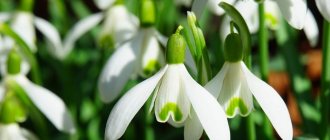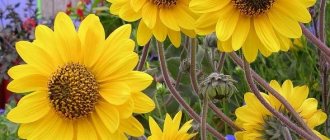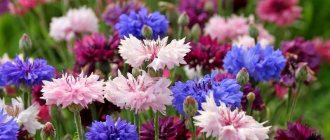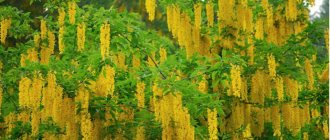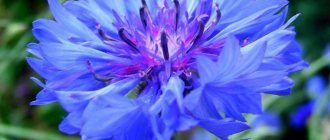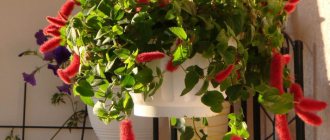Author: Elena N. https://floristics.info/ru/index.php?option=com_contact&view=contact&id=19 Category: Garden plants Published: June 22, 2018Last edits: November 05, 2020
- Growing conditions
- Diseases and their treatment
- Alpine snowdrop (Galanthus alpinus = Galanthus schaoricus)
Snowdrop, or galanthus (lat. Galanthus) is a genus of herbaceous perennials of the Amaryllis family, which includes 18 species and two natural hybrids. The scientific name of the genus is translated from ancient Greek as milky-flowered and characterizes the color of the flowers of the plant. To the English, galanthus is known as “snow earring” or “snow drop”, to the Germans as “snow bell”, and in our country it is called “snowdrop” for its early appearance on soil that is still dead after winter - literally “from under the snow”. The largest number of species of this plant (16) can be found in the Caucasus, and 6 of them are listed in the Red Book because they are endangered. Many types of snowdrops are grown as ornamental plants, and they were introduced into cultivation a very long time ago. For example, the terry form Flore Pleno has been known since 1731. There are many wonderful legends about snowdrops. One of them tells that on the day when Adam and Eve left Eden, it was snowing, and frozen Eve cried, and the Creator, to console her, turned several snowflakes into the very first flowers on Earth - snowdrops.
Planting and caring for snowdrops
- Flowering: in the first half of spring, sometimes already from the end of March.
- Planting: planting bulbs in the ground - from July to November.
- Lighting: bright sunlight.
- Soil: loose, moist, well-drained. Rain or melt water should not stagnate on the site.
- Watering: only needed if the winter was snowless and spring came without rain.
- Fertilizing: mineral complexes with low nitrogen content.
- Reproduction: mainly by children separated from the mother bulb, less often by seeds.
- Pests: caterpillars of moths, nematodes, slugs, moles and mice.
- Diseases: rust, gray rot, chlorosis.
Read more about growing snowdrops below.
Galanthus – photo
You probably already know what galanthus looks like in the forest or on the plot. But we have already found out that there are much more species of it than is commonly believed. Look and compare!
Photo: frustratedgardener.com
Photo: araratpark-hyatt.ru
Photo: atlas.roslin.pl
Photo: orpro.ru
Photo: zen.yandex.ru
Photo: rosecatalog.ru
Photo: pinterest.ru
Photo: oir.mobi
Photo: badfon.ru
Photo: oir.mobi
Photo: uooptkk.ru
Photo: pxhere.com
Photo: build-together.ru
Photo: rozisad.ru
Photo: plantsam.com
Photo: plant-identification.net
Photo: botanichka.ru
Photo: landscapetnik.com
Photo: m.ok.ru
Photo: liveinternet.ru
Photo: frustratedgardener.com
Photo: pxhere.com
Photo: pxhere.com
Photo: msk.mr7.ru
Did you like the post? Subscribe to our channel in Yandex.Zen, it really helps us in our development!
Botanical description
Snowdrops are perennial bulbous plants with a short growing season, the duration of which directly depends on the climate of the growing region. Bulbs with a diameter of 2-3 cm consist of scales aged from one to three years. Every year, three scales grow on the bulb, in the axils of which children are formed. Shiny or matte, smooth or folded, keeled on the underside, snowdrop leaves appear simultaneously with the flowers. They can be painted any shade of green. The flower arrow of snowdrops, round or slightly flattened in cross-section, shiny or glaucous, ends with a bract and a drooping flower. By the end of flowering, the arrow becomes hollow. The bract consists of two bracts, and the perianth consists of six leaflets: three completely white outer ones and three inner ones - white with a green spot formed by streaks located closer to the top. Snowdrops bloom in the first half of spring, their flowers are pollinated by insects. The Galanthus fruit is an opening fleshy capsule with spherical seeds.
Planting snowdrops in open ground
When to plant
It is best to buy and plant snowdrop bulbs from July to September, and if the autumn is warm and long, then until November. Try not to purchase planting material with open flowers, since immediately after planting they wither and die. True, the bulb remains alive, but next year such plants bloom weakly and may not bloom at all. When choosing planting material, give preference to dense, heavy bulbs with intact protective shells, without signs of the beginning of growth - roots and primordia of peduncles, since bulbs that have begun to grow will have to be planted in the ground immediately. It’s not scary if there are cuts on the bulb, as long as the scales are not damaged. Do not take crumpled or broken specimens: bruised and crushed areas will almost certainly rot later.
In the photo: Growing snowdrops
Purchased planting material can be stored for no longer than a month, but if you do not have the opportunity to plant the bulbs in the ground on time, store them in a perforated plastic bag, sprinkled with shavings or sawdust.
- Fir: cultivation, propagation, types and varieties
How to plant
Spring snowdrops love open areas, although they also grow well in the partial shade of trees and bushes. The soil for these primroses is preferably moist, well-drained and loose, but it is better not to grow them in places where water stagnates and in heavy clay soils. It is interesting that snowdrop flowers themselves regulate the planting depth: if you immerse the bulb in the soil too deeply, the plant will form a new bulb on the peduncle, but at the depth it needs; if planting is not deep enough, the bulbs will also begin to become smaller over time, but will be active grow into children.
In any case, you need to immerse the snowdrop bulbs into the soil at least 5 cm. Primroses look more beautiful in a group of 10-30 plants.
Interesting Facts
Absolutely all types of snowdrops are protected objects; moreover, their rarest species are at the stage of extinction, and it is possible to bring these species back to life only if they are grown in culture.
The name of the flower is of Greek origin, therefore it is translated as milky flower, which most likely reflects the color of the inflorescence. People say that it was given this name for its ability to grow among the snow and bloom with the first breath of spring, regardless of weather conditions.
There are many legends about these amazing delicate flowers. For example, about Adam and Eve. When they were expelled from the Garden of Eden, the winter cold reigned all around, and snow was blowing. Eve cried from the cold, remembering the lost warmth of paradise. To console her, God created some snowdrops from the swarming snowflakes. This means that they are not only the first spring flowers, but also the first flowers on our planet.
Caring for snowdrops in the garden
Growing conditions
Planting snowdrops and caring for the first spring flowers in the open ground is surprisingly simple. There is no need to water snowdrops, since the soil in the spring after the snow melts is saturated with moisture. If the winter was snowless and the spring was dry, then from time to time the soil in the area should be moistened, otherwise the snowdrops will not grow tall. There is no need to weed either: at this time the weeds are not yet growing. But fertilizing will not be superfluous, but certain restrictions must be observed in this matter: it is undesirable to apply fertilizers with a high nitrogen content to the soil, which stimulates the intensive growth of leaf mass, the abundance of which in conditions of high humidity and low air temperature can become the basis for the development of fungal diseases. Choose mineral complexes for snowdrops that contain more potassium and phosphorus fertilizers, since potassium promotes the formation of strong and healthy bulbs that winter well in the soil, and phosphorus stimulates the flowering of snowdrops.
Scilla flower - not to be confused with snowdrops
Transfer
Snowdrops are transplanted from one place to another once every five to six years, although they can grow in one area for much longer. The fact is that in one season, up to two children are formed on the bulb, that is, in six years it can become heavily overgrown with daughter bulbs, which will eventually begin to suffer from lack of nutrition. That’s why the bulbs need to be divided and planted.
In the photo: How snowdrops bloom
Reproduction
To divide and replant, snowdrops are dug up while its leaves have not yet completely withered and dried out. The bulbs are divided without clearing the soil, and after dusting the sections with coal powder, they are immediately planted in soil prepared in advance.
Snowdrops are also grown by seed, but there is no point in wasting time sowing seeds, since snowdrops reproduce well by self-sowing. The emerged seedlings will bloom in 4-5 years.
- Tips for growing tomato seedlings
Growing the earliest spring flowers - primrose
Snowdrops after flowering
At the end of flowering, the leaves of snowdrops are not cut off immediately, but only when they die naturally, otherwise you will disrupt the process of restoration of the bulb, without which flowering next year will become impossible. In addition, the leaves help the bulbs accumulate nutrients so they can overwinter properly in the ground.
If you planted snowdrops in the ground before winter, you need to cover the area with a layer of peat or humus in late autumn.
Plant propagation
All types of galanthus can reproduce in two ways: seeds and bulbs.
No special conditions are required for sowing seeds. Immediately after collection, the seeds are sown in the ground.
However, with this method of snowdrop propagation, the time from planting to flowering can take about 4 years.
In bulbous or vegetative propagation, snowdrops use daughter bulbs that grow on the plant after the flowering season. Propagating galanthus in this way will allow you to observe the flowering of new plants within 2 years.
Pests and diseases
Diseases and their treatment
Snowdrops can suffer from fungal or viral infections. When infected by viruses, light green and yellowish streaks and marks appear on the ground organs of the plant, the texture of the leaves becomes bumpy, and the edges of the leaf blade curl up. The diseased specimen should be burned immediately, and the place where it grew should be spilled with a strong solution of potassium permanganate.
In the photo: Flowering snowdrops - the earliest flowers
Black or brown streaks and spots on the leaves of snowdrops may indicate they are affected by rust, and a fluffy gray coating is a sign of gray rot. Affected organs and areas should be cut out and burned, and the plants and soil around them should be treated with a solution of a fungicidal preparation prepared according to the instructions.
Yellow spots on snowdrop leaves may be a sign of chlorosis, which occurs due to poor drainage or iron deficiency in the soil. Add this element to the soil in chelated form, and the plant will gradually recover.
Pests and their control
Among insects, caterpillars of cutworm butterflies and nematodes pose a danger to snowdrops. Cutworm caterpillars that damage flower bulbs are collected and destroyed in the fall during weeding, when they are preparing to pupate. Controlling nematodes is much more difficult. Nematodes are very small worms that cannot be seen with the naked eye, but the consequences of their destructive activity are clearly visible: yellowish tumors of irregular shape appear along the edges of snowdrop leaves, and a dark spot is visible on the cut of the bulb, which separates the affected part from the healthy one. Sick plants are destroyed, and healthy ones are dug up, washed from the ground and kept for 3-4 hours in water at a temperature of 40-45 ºC. In the area where nematodes were found, bulbous plants are not planted for 5 years.
But insects are not the only enemies of snowdrops. Rodents also annoy the flowers - moles and mice, damaging flower bulbs underground or dragging them into their holes. The bulbs in places where they have been chewed begin to rot, the plants grow poorly and look depressed. It is necessary to remove diseased bulbs, cut off rotting areas to healthy tissue, sprinkle the sections with ash or charcoal powder and let them dry. You can save snowdrop bulbs from mice if you do not plant perennials that form clumps or herbaceous plants with turf in which mice live in a diameter of three meters: mice do not go further than three meters from their nests. As for moles, they need to lay out traps and bait with poison throughout the area.
- Will a live Christmas tree survive in a container if it is planted in the ground after the holidays are over?
Underground slugs that live in rich clay soils can also harm snowdrops. Gastropods are destroyed using special means, but when planting, it is best to fill the bulb to the very top with coarse-grained river sand, and only then fill the remaining space of the hole with soil.
Application
Snowdrops can be used as decoration and home decoration. Bouquets of snowdrops do not wither for a long time and stand in water for a long time. Snowdrops look bright and elegant. Snowdrops also effectively decorate gardens. In the form of “carpets”, snow-white lawns on a clean lawn, flowers look advantageous.
Snowdrops should be planted together, several dozen at a time. Snowdrops have one drawback: the above-ground part dies off early. You can get rid of this drawback by planting the plant in a flower garden. They can be planted next to large flowers with voluminous leaves. The main thing is not to completely deprive flowers of light during the active period. When planting, choose the illuminated side. During the rest period, they are not afraid of shadows and darkness.
Don’t worry about falling leaves, you don’t need to remove them, they are a hindrance to the flowers. Snowdrops will inevitably grow through them in spring. Rotten leaves provide great nutrition to the bulbs and help maintain moisture. If you need to remove old foliage, do it in the fall. In spring, you run the risk of damaging young plants.
Partnership
Snowdrops are combined with lungwort, primrose, scillas and corydalis. It is permissible to plant snowdrops with perennial plants: peonies or ferns.
Types and varieties
At the beginning of the article, we wrote that scientists have described 18 species of snowdrop, but in fact there is still no certainty on the question of what is considered a species and what is a variety or form. We offer you an introduction to the most famous cultivated plants of the Snowdrop genus, but whether it is a species or a variety does not matter much for cultivation.
Alpine snowdrop (Galanthus alpinus = Galanthus schaoricus)
Endemic to Western Transcaucasia with a bulb up to 3.5 cm long and up to 2 cm in diameter. The leaves of the plant are dark green with a bluish bloom, broadly lanceolate, the peduncle is 6 to 9 cm high, the flowers are white.
In the photo: Alpine snowdrop (Galanthus alpinus = Galanthus schaoricus)
Caucasian snowdrop (Galanthus caucasicus)
Grows in the forests of the lower and middle zones of Central Transcaucasia. It has flat linear bluish leaves up to 30 cm long, peduncles up to 10 cm high and white fragrant flowers up to 2.5 cm long and up to 1.5 cm in diameter. On the inner perianth lobes there are green spots located closer to the ends of the petals. The plant has been in cultivation since 1887.
In the photo: Caucasian snowdrop (Galanthus caucasicus)
Bortkevich's snowdrop (Galanthus bortkewitschianus)
Endemic to the North Caucasus, named after the outstanding dendrologist and forester V.M. Bortkevich. This plant has a bulb 3-4 cm long with a diameter of 2-3 cm, dark green lanceolate leaves covered with a bluish bloom, a flower arrow up to 6 cm high and white flowers with green spots.
In the photo: Bortkevich's snowdrop (Galanthus bortkewitschianus)
Cilician snowdrop (Galanthus cilicicus = Galanthus rizehensis)
It is found in the mountains and foothills of Asia Minor and in the Batumi region. It is a plant with linear dark green matte leaves, a peduncle up to 18 cm long and white flowers with green spots on the inner tepals.
In the photo: Cilician snowdrop (Galanthus cilicicus = Galanthus rizehensis)
Elvis's snowdrop (Galanthus elwesii)
Named after the famous collector John Henry Elvis. The species is found in the mountains of South-Eastern Europe and Asia Minor, in Moldova and in the Odessa region of Ukraine. It is a tall plant, the flower shoots of which can reach a height of 25 cm. The leaves of the Elvis snowdrop are wide, bluish-green, the flowers are fragrant, large, spherical. The species is variable: in European gardening, 15 forms of the Elvis snowdrop are cultivated. For example:
- Galanthus elwesii var. maxima is a plant with larger leaves with wavy edges than the main species.
Pictured: Elvis's snowdrop (Galanthus elwesii)
Snowdrop (Galanthus plicatus)
Grows in the foothills of Moldova, Romania and Crimea. He is one of the largest representatives of the genus. A special feature of the folded snowdrop is the outwardly curved edges of the leaves. From the beginning of flowering, the leaves are covered with a bluish coating, then they become dark green and shiny. Peduncles stretch up to 25 cm in height. Flowers up to 3 cm long and up to 4 cm in diameter have a strong, pleasant aroma. The species has been in culture since 1592. There are about a dozen garden forms of this species, the most popular of which is Wagram, a variety with double flowers.
In the photo: Snowdrop (Galanthus plicatus)
Snowdrop (Galanthus platyphyllus = Galanthus latifolius)
It grows in the alpine and subalpine zones of the Main Caucasus Range and is one of the most promising plants for cultivation in the northern zone. Its bulbs are up to 5 cm long and up to 3 cm in diameter, the leaves are shiny, dark green, the peduncle is from 10 to 20 cm long, the flowers are white with a green spot.
In the photo: Broadleaf snowdrop (Galanthus platyphyllus = Galanthus latifolius)
Icarian snowdrop (Galanthus ikariae)
Grows in calcareous, rocky and sandy soils in moist, shady places in Greece. Its bulb is up to 3 cm long and up to 2.5 cm in diameter, the leaves are dull, green, the peduncle is up to 21 cm high, the flowers are white with a green spot.
In the photo: Icarian snowdrop (Galanthus ikariae)
Snowdrop (Galanthus nivalis)
It is found among bushes, on the edges and open areas of the lower middle and alpine zones of the Ciscaucasia and the mountains of Southern and Central Europe. This early spring plant is the most popular among garden snowdrops. It has a rounded bulb up to 2 cm in diameter, flat bluish or dark green leaves, peduncles reaching a height of 12 cm and single drooping fragrant white flowers up to 3 cm in diameter with a green spot at the ends of the inner tepals. The snowdrop has up to 50 garden forms, including terry:
- var. flore-pleno - a plant with peduncles up to 10 cm high and a perianth consisting not of 6, but of 12 large leaves with yellow-green spots;
- Lady Elphinstone is a plant with double white flowers and yellow markings on the inner circle segments;
- Galanthus nivalis subsp. Angustifolius is a narrow-leaved form of the white snowdrop, differing from the main species in its smaller size.
In the photo: Snowdrop (Galanthus nivalis)
The most commonly grown snowdrop varieties are:
- Arnott - snowdrop with wide and short outer tepals;
- Lutescens is a capricious variety with pale and delicate flowers;
- Scharlockii is a plant with a small flower and a long wing on the flower stalk.
Also popular are the snowdrop varieties Ophelia, Passy Green Tip and Viridapicis.
general information
Galanthus is a herbaceous perennial and one of the earliest primroses. He doesn't even have to wait for the snow to completely melt. The scaly bulbs of galanthus are very small - up to 4 cm, but at the same time they are densely covered with children literally within a season.
Galanthus flowers resemble drooping bells of pure snow-white color. Gradually they fade, and the peduncle dies, so there is no need to cut it specially. Galanthus is an excellent option for the northern regions of our country.
Photo: pxhere.com
